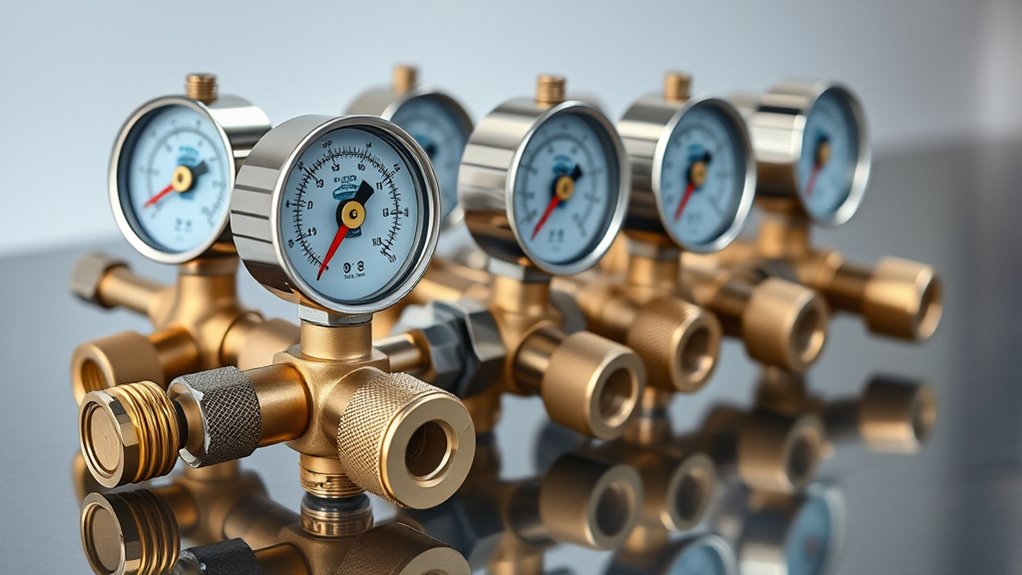If you’re looking for the 11 best hydrogen-rated pressure regulators, I recommend focusing on models that combine durability, safety, and precise control. These regulators feature materials resistant to embrittlement and corrosion, with robust construction and accurate gauges. Many include safety certifications and easy adjustment features for reliable performance over time. To guarantee the best fit for your needs and learn about top options, keep exploring—you’ll find the perfect match with ease.
Key Takeaways
- Choose regulators made from high-grade stainless steel or specialized alloys to resist embrittlement and corrosion in hydrogen applications.
- Ensure the regulator features leak-proof seals, dual-scale gauges with acrylic lenses, and safety certifications for hydrogen use.
- Opt for models with precise piston design and fine adjustment mechanisms for stable pressure control within ±1 PSI.
- Verify compatibility with hydrogen standards like ASME, ISO, and CE, and look for units with safety relief features.
- Prioritize regulators with long service life, durability, and easy maintenance to ensure safe, reliable performance over time.
High Pressure Nitrogen Regulator (CGA-580, 0-4500 PSI)
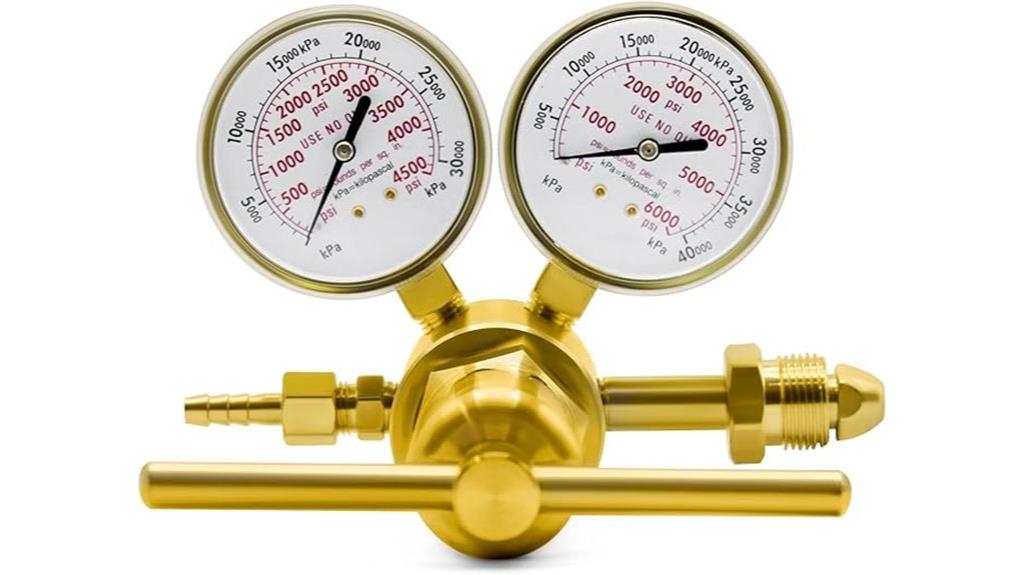
If you’re working with high-pressure nitrogen, the Hydrogen-Rated Pressure Regulator (CGA-580, 0-4500 PSI) is an ideal choice because it offers precise pressure control and durability under demanding conditions. Its single-stage piston design stabilizes outlet pressure accurately from 0 to 4500 PSI, making it reliable for heavy-duty applications. The dual gauges—one for inlet and one for outlet—are protected by scratch-resistant covers and rubber bumpers, ensuring longevity. Built from robust brass, it’s designed to withstand tough environments, with easy-to-operate handles and fittings that secure connections. This regulator combines precision, durability, and ease of use, making it a dependable tool for high-pressure nitrogen regulation.
Best For: professionals and industrial users needing precise, durable high-pressure nitrogen regulation in demanding environments.
Pros:
- Single-stage piston design provides accurate and stable outlet pressure from 0 to 4500 PSI.
- Durable brass construction ensures long-lasting performance under high-pressure conditions.
- Dual gauges with scratch-resistant covers and rubber bumpers extend the lifespan and protect vital readings.
Cons:
- Heavier weight of 4.84 pounds may require secure mounting or handling support.
- No digital readout or electronic controls for advanced pressure monitoring.
- Limited to nitrogen and inert gases with CGA-580 inlet connection, reducing versatility for other gases.
Nitrogen High Pressure Regulator (0-4000 PSI)
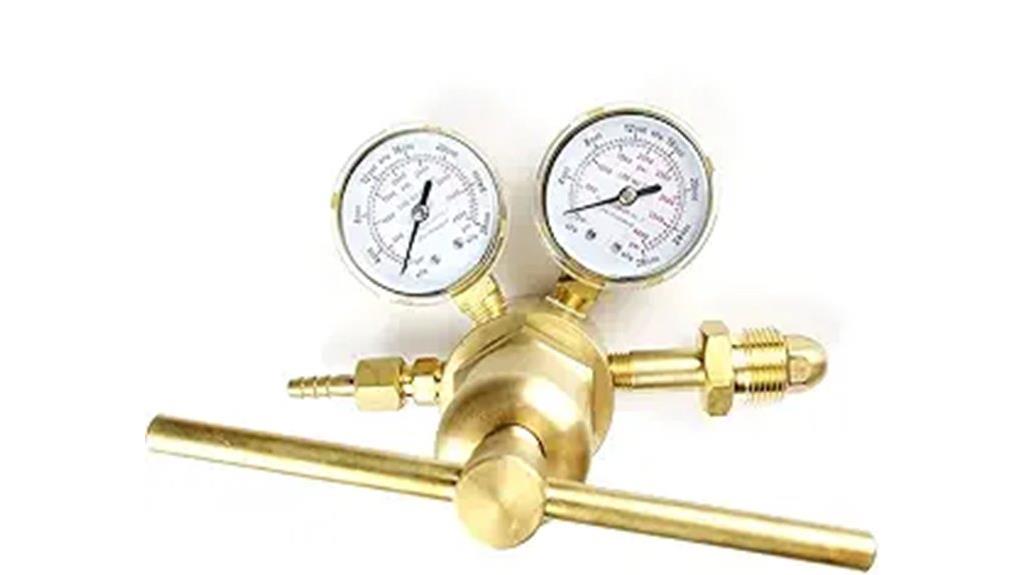
The Nitrogen High Pressure Regulator (0-4000 PSI) is ideal for demanding industrial applications that require precise and reliable control of inert gases at very high pressures. Made from forged brass, it features a single-stage piston design for consistent pressure reduction, with safety mechanisms like an overload degassing device and a sintered inlet filter. Its large T handle allows easy manual adjustments, while over-scaled gauges provide accurate readings at high pressures. Suitable for gases like nitrogen, argon, helium, and CO₂ (with proper adapters), this regulator is perfect for heavy-duty tasks such as system purging and testing, ensuring safety and performance in challenging environments.
Best For: industrial technicians and professionals needing high-pressure inert gas regulation for applications like system testing, purging, and maintenance.
Pros:
- Robust forged brass construction ensures durability in heavy-duty environments
- Single-stage piston design provides consistent and reliable pressure reduction
- Large T handle offers easy, precise manual adjustments and over-scaled gauges enhance accuracy at high pressures
Cons:
- Requires proper adapters for gases like CO₂, adding setup complexity
- Limited to inert gases; not suitable for reactive or flammable gases
- Manual adjustment may be less convenient for automated or remote operations
Cash Acme EB45 Pressure Regulating Valve
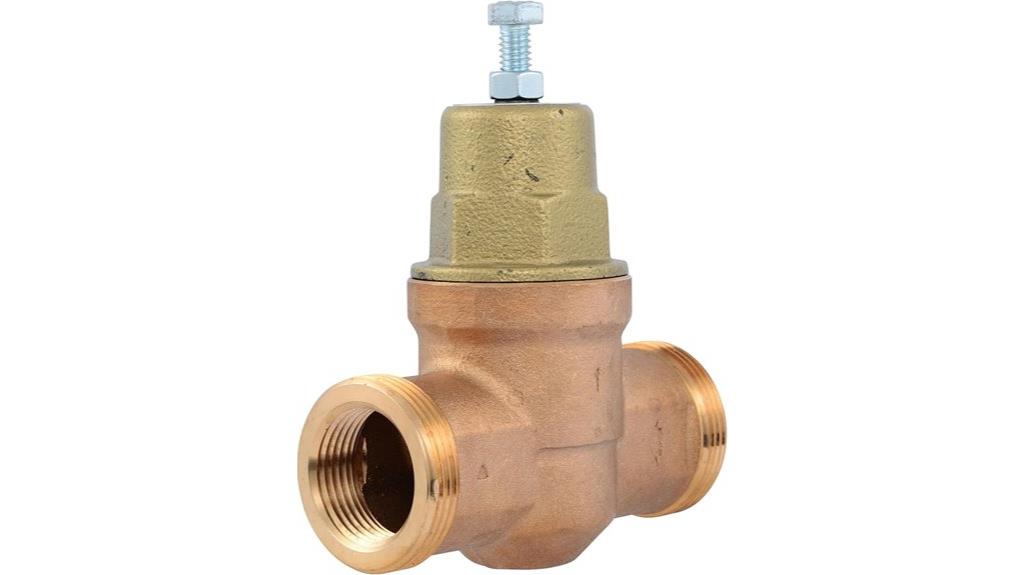
The Cash Acme EB45 Pressure Regulating Valve stands out for its reliable performance in residential and commercial water systems, especially when precise pressure control matters. Designed with a compact inline structure, it features a tamper-resistant locking mechanism to prevent accidental adjustments. Its easy-to-access, half-cartridge design simplifies calibration, ensuring consistent downstream pressure. Made from corrosion-resistant brass, stainless steel, and durable components, it meets NSF/ANSI 372 standards for potable water safety. Rated for 60 PSI and adjustable between 10 to 70 PSI, it handles hot and cold water up to 180°F, providing dependable, safe, and efficient water pressure regulation.
Best For: homeowners and commercial property managers seeking reliable, adjustable pressure regulation for potable water systems to ensure safety and efficiency.
Pros:
- Easy-to-access half-cartridge design simplifies calibration and adjustments
- Tamper-resistant locking mechanism prevents unauthorized modifications
- Constructed from corrosion-resistant materials meeting NSF/ANSI 372 standards
Cons:
- Limited to a maximum of 70 PSI adjustment range, which may not suit all high-pressure applications
- Requires a 1-inch NPT connection, which may not fit smaller or larger pipe sizes
- Installation may require some basic plumbing knowledge for optimal setup
JOEJET Pressure Washer Pressure Regulator (M22 Connector)
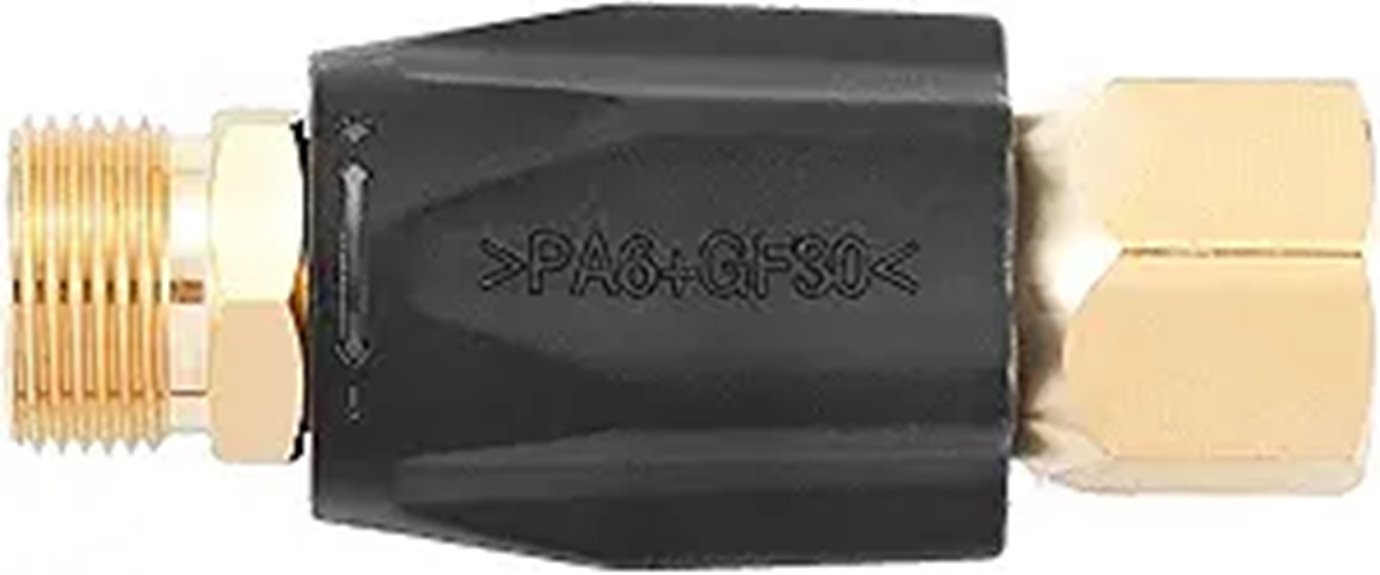
Looking for a reliable pressure regulator that offers precise control and durability during heavy-duty cleaning? The JOEJET Pressure Washer Pressure Regulator is an excellent choice. It’s rated up to 4000 PSI and features M22 threaded connections on both ends, ensuring compatibility with most pressure washer guns, wands, and accessories. Made from durable brass with a rubber exterior, it withstands high pressures and temperatures up to 140°F. Its compact, lightweight design makes it portable and easy to handle. The twist mechanism allows quick, accurate pressure adjustments, helping you tailor settings for different surfaces. Overall, it’s a robust, user-friendly option for safe, efficient pressure washing.
Best For: homeowners and professional cleaners seeking a durable, adjustable pressure regulator compatible with high-pressure washers for versatile and safe cleaning tasks.
Pros:
- Made from heavy-duty brass with rubber exterior for enhanced durability and high-pressure resistance
- Easy-to-use twist mechanism for quick and precise pressure adjustments
- Compatible with most pressure washer guns, wands, and accessories thanks to M22 threaded connections
Cons:
- Weighs approximately 9.6 ounces, which may be considered slightly heavy for extended use
- Some users suggest including additional adapters for broader compatibility with different equipment
- Limited to a maximum of 4000 PSI, which might not suit extremely high-pressure applications
LOOPHILL VN-500 Nitrogen Purging Regulator
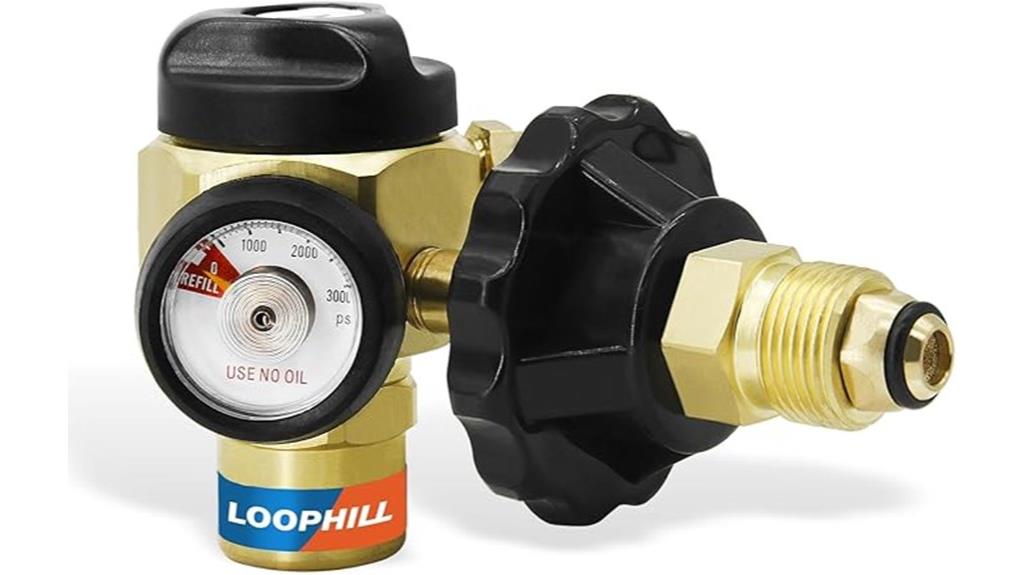
For professionals seeking reliable nitrogen control during high-pressure purging tasks, the LOOPHILL VN-500 Nitrogen Purging Regulator stands out with its precise pressure management and multiple operational modes. It offers four modes—TST, PRG, BRZ, and OFF—allowing tailored control for testing, purging, brazing, or shutdown. Managing pressures from 0 to 500 PSI, it ensures accurate adjustments for sensitive applications. Its hybrid design combines a regulator and flow meter in a compact, easy-to-use unit. Made of forged brass, it’s highly durable and resistant to corrosion. With standard CGA-580 connectivity and dual 1/4 NPT outlets, it’s versatile for various industrial needs, ensuring safety and reliability.
Best For: professionals in industrial, HVAC, and welding fields requiring precise nitrogen control during high-pressure purging, leak testing, or brazing tasks.
Pros:
- Offers four customizable operational modes (TST, PRG, BRZ, OFF) for versatile applications
- Constructed from durable forged brass with excellent corrosion resistance
- Integrated flow meter provides real-time, accurate flow readings for easier operation
Cons:
- May require some familiarity with pressure regulation for optimal use
- Limited to nitrogen, so not suitable for other gases without additional equipment
- The dual 1/4 NPT outlets might need adapters for some specific fittings
RVGUARD Water Pressure Regulator Valve with Gauge and Inlet Screen

If you’re seeking a reliable water pressure regulator for your RV or camper, the RVGUARD Water Pressure Regulator Valve with Gauge and Inlet Screen stands out with its easy-to-use adjustable knob and built-in pressure gauge. It features 3/4 garden hose threads, making it compatible with all American water sources. The regulator is designed to protect your plumbing system from high-pressure damage, with a factory setting of 45 PSI that you can easily adjust by hand. Its durable, lead-free brass construction and inlet screen filter ensure safe, clean water flow. Simple to operate and maintain, it provides precise pressure control for safe, reliable RV water systems.
Best For: RV owners, campers, and travel trailer users seeking an easy-to-adjust, reliable water pressure regulator with monitoring features.
Pros:
- Easy to adjust pressure manually without tools, thanks to a user-friendly knob.
- Built-in gauge provides real-time pressure monitoring for safe water flow.
- Made from lead-free brass with an inlet screen filter for durability and clean water quality.
Cons:
- May require initial setup to calibrate to desired pressure levels.
- Compatibility limited to American water sources with 3/4 garden hose threads.
- The mechanical gauge could potentially be damaged if subjected to rough handling.
VN-650 Flowmeter Nitrogen Purging Regulator
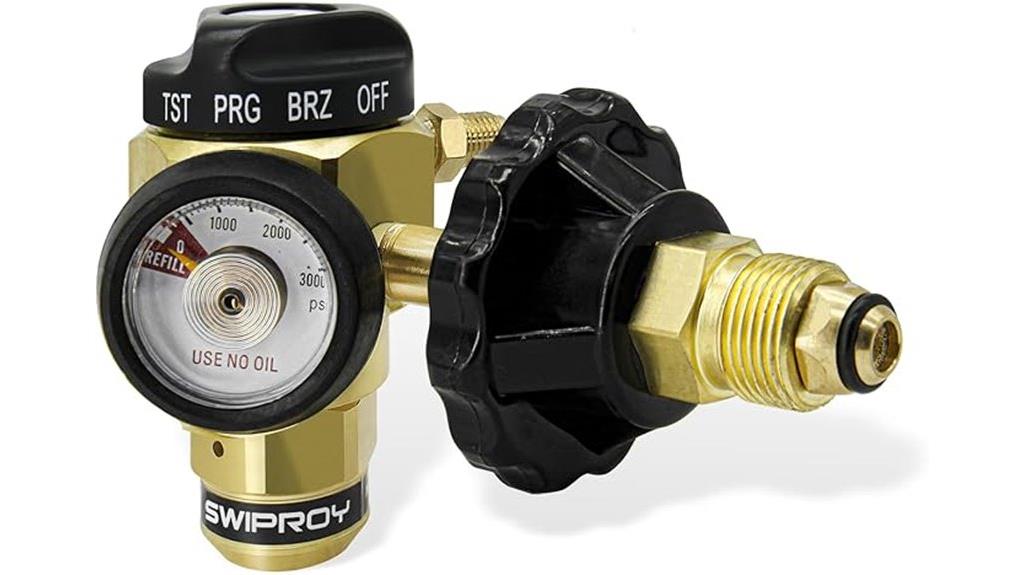
The VN-650 Flowmeter Nitrogen Purging Regulator stands out as an ideal choice for professionals who need a versatile and reliable tool for high-pressure nitrogen applications. It integrates purging, brazing, and pressure testing functions into a single unit, with preset parameters for each task. Made from durable brass, it resists corrosion and pressure fluctuations, ensuring long-term performance. With a maximum operating pressure of 650 psi and CSA and ULC certifications, it meets safety standards. Its compact design and easy-to-use globe valve make it suitable for industrial environments. Customers appreciate its reliability, though some note it ranks lower in overall ratings, making it a solid option for precise nitrogen control.
Best For: professionals in industrial, welding, or manufacturing environments seeking a durable, multi-functional nitrogen purging regulator for high-pressure applications.
Pros:
- Combines purge, braze, and pressure test functions into a single unit for versatile use.
- Made from rugged brass, offering excellent corrosion and pressure resistance for long-term durability.
- Meets CSA and ULC safety standards, ensuring reliable and safe operation at up to 650 psi.
Cons:
- Some users have rated it lower overall, indicating potential issues with consistency or features.
- Slightly heavier at 2.77 pounds, which may impact portability in some applications.
- Limited to preset parameters, which may not suit all specific nitrogen control needs.
LOOPHILL VN-650 Nitrogen Regulating Valve
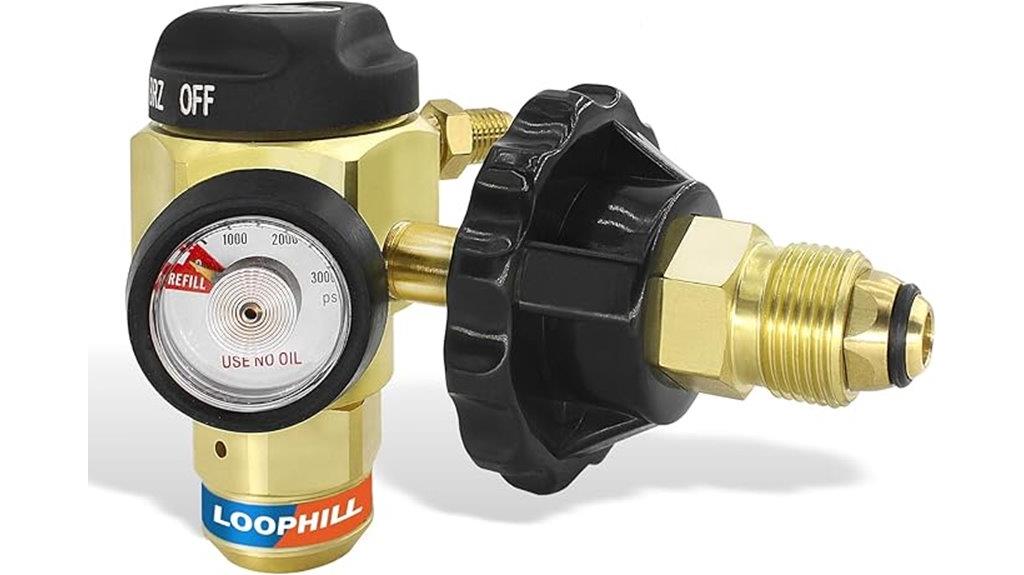
The LOOPHILL VN-650 Nitrogen Regulating Valve stands out with its heavy-duty brass body, which offers exceptional corrosion resistance and pressure stability—making it ideal for professionals handling high-pressure nitrogen purging tasks. Its compact, hybrid design combines a regulator and flow meter, providing precise, real-time feedback through clear, intuitive readings. The regulator connects directly to nitrogen tanks via standard CGA-580 and 1/4 NPT dual-threaded outlets, with a tool-less hand wheel for quick, secure attachment. Supporting four modes—TST, PRG, BRZ, and OFF—it allows accurate flow and pressure adjustments up to 650 PSI. This robust, versatile regulator is perfect for leak testing, pipeline purging, and industrial gas control.
Best For: Professionals in industrial, HVAC, and welding fields requiring precise nitrogen flow control for leak testing, pipeline purging, and brazing.
Pros:
- Heavy-duty brass body offers excellent corrosion resistance and durability
- Compact hybrid design with integrated flow meter for real-time, accurate readings
- Tool-less connection with quick mode switching enhances ease of use and efficiency
Cons:
- Limited to a maximum pressure of 650 PSI, which may not suit extremely high-pressure applications
- Availability scheduled for February 18, 2025, potentially delaying immediate purchase
- May require periodic maintenance with included O-rings for optimal performance
Dwyer Series MPR Miniature Pressure Regulator

Dwyer’s Series MPR Miniature Pressure Regulator is an excellent choice for low-pressure applications requiring compact, reliable regulation of air or water. Its zinc body and 0-5 psi pressure range make it ideal for tasks like pressurizing drums or providing small air supplies. The adjustable, non-rising knob with locking capability guarantees easy, precise settings. Designed for simplicity and durability, it’s self-relieving for air models and non-relieving for water. While it offers stable pressure output, it’s not suited for highly precise, long-term regulation. Its small size and straightforward installation make it a practical solution for many low-pressure needs.
Best For: those needing a compact, reliable, low-pressure regulator for air or water in applications like pressurizing drums or small air supplies.
Pros:
- Compact and lightweight design for easy installation and space-saving use
- Simple adjustment with a locking, non-rising knob for precise control
- Durable zinc body suitable for air and water applications
Cons:
- Not suitable for applications requiring highly precise or long-term pressure stability
- Mounting nut and bracket often sold separately, increasing overall cost
- Slight pressure fluctuations may occur under varying input conditions
Ozone Therapy Low Flow Oxygen Regulator
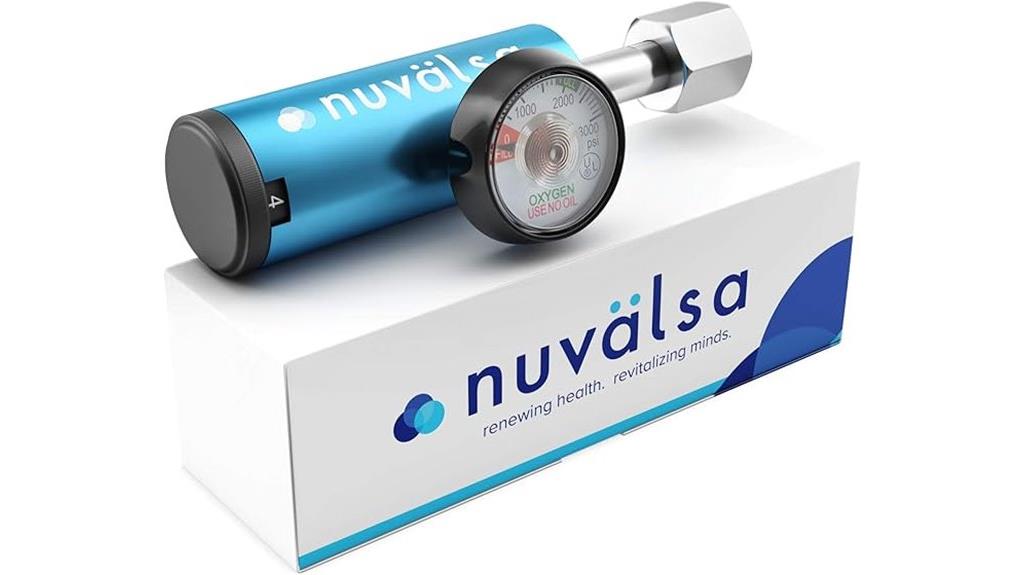
For those seeking precise and reliable oxygen regulation in ozone therapy, the Ozone Therapy Low Flow Oxygen Regulator by Nuvälsa stands out. Its durable metal construction, German engineering, and secure CGA 540 connection ensure long-lasting performance. With adjustable flow from 1/32 to 4 LPM at 50 PSI, it offers fine-tuned control for sensitive treatments. The pressure gauge and wrench-tightened fittings promote safety and leak-free operation. Rated 4.5 stars based on user feedback, it’s praised for its accuracy, versatility, and durability across medical, industrial, and ozone therapy applications. This regulator provides dependable, cost-effective oxygen delivery for demanding low-flow needs.
Best For: medical professionals, ozone therapy practitioners, and industrial users seeking precise, reliable low-flow oxygen regulation for sensitive treatments and applications.
Pros:
- Highly adjustable flow rates from 1/32 to 4 LPM for precise control
- Durable metal construction with German engineering quality for long-lasting performance
- Secure CGA 540 connection and leak-free operation with pressure gauge and wrench-tightened fittings
Cons:
- Initial setup may cause leaks if connections are not properly sealed
- Limited to oxygen cylinders up to 3,000 PSI, requiring compatible equipment
- May be more expensive than basic regulators due to advanced features and build quality
High-Pressure Piston Regulator for Inert Gases
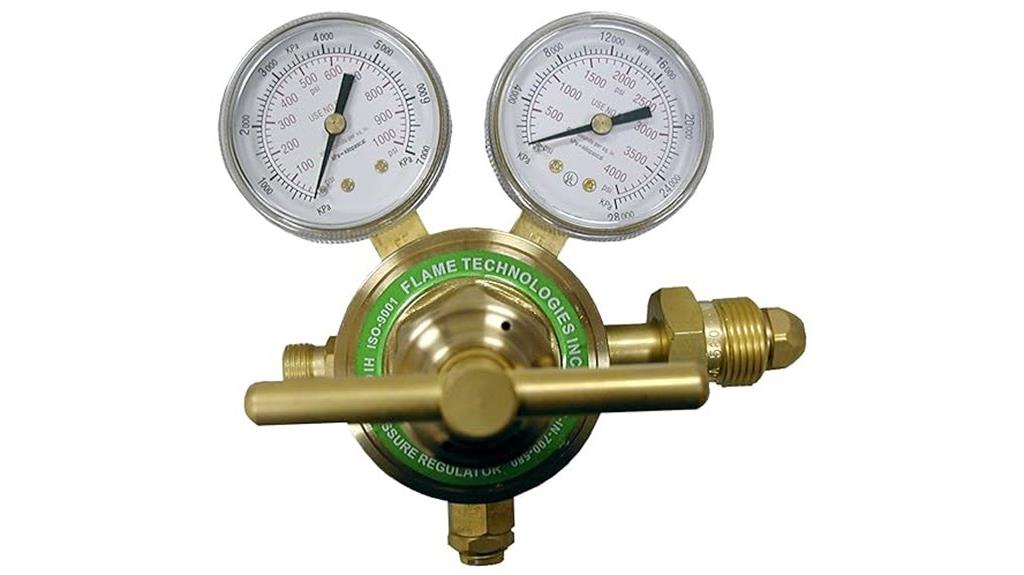
Looking for a reliable regulator that can handle demanding inert gas applications at high pressures? The Flame Tech HPPR-IN-700-580 High Pressure Piston Regulator is designed for nitrogen and argon, with a forged brass body for durability. It manages inlet pressures up to 3000 PSI and delivers pressures from 50 to 700 PSI, making it ideal for welding, leak testing, and refrigeration work. Its piston design stabilizes flow, while a clear, dual-scale gauge simplifies adjustments. Easy to connect and maintain, it offers dependable performance, though some users report calibration quirks and minor leak issues at higher pressures. Overall, it’s a solid choice for high-demand inert gas tasks.
Best For: professionals requiring reliable high-pressure inert gas regulation for welding, leak testing, and refrigeration applications in demanding environments.
Pros:
- Robust forged brass construction ensures durability and long service life
- Precise piston design stabilizes flow and provides accurate pressure control
- Clear dual-scale gauge with acrylic lens allows easy monitoring and adjustments
Cons:
- Calibration discrepancies may require user adjustments or expectations management
- Limited adjustment range (about 1.5 turns) can make fine-tuning difficult at higher pressures
- Some units have reported leaks at diaphragm seams under higher pressure conditions
Factors to Consider When Choosing a Hydrogen‑Rated Pressure Regulator
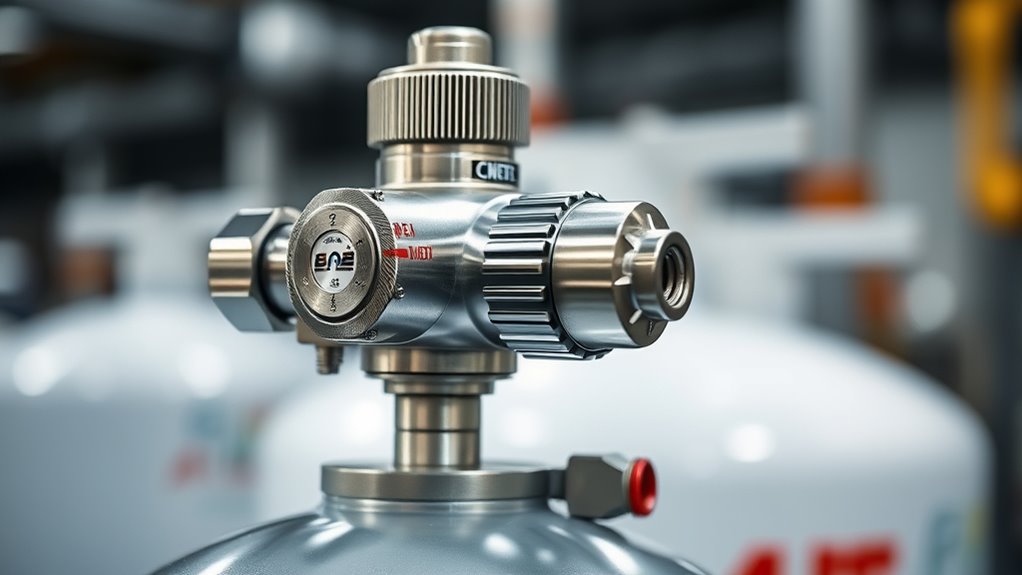
When selecting a hydrogen-rated pressure regulator, I look closely at its compatibility with hydrogen and whether it covers the required pressure range. I also consider the materials used, verifying they meet durability standards, and check connection types and safety certifications. These factors help ensure safe, reliable operation tailored to my specific application.
Compatibility With Hydrogen
Choosing a hydrogen-rated pressure regulator requires ensuring that all materials and components are compatible with hydrogen to prevent issues like embrittlement and corrosion. I look for regulators made from stainless steel or brass, as these materials resist hydrogen-induced damage. Secure, leak-proof connections, such as CGA-580 fittings, are essential to handle high-pressure hydrogen safely. I also verify that seals and diaphragms are made from hydrogen-compatible materials to avoid degradation over time. Proper certification, like ASME or ISO standards, signals that the regulator meets safety and performance benchmarks for hydrogen service. Compatibility isn’t just about materials; it’s about ensuring every part can withstand hydrogen’s unique properties, providing a safe, reliable, and long-lasting solution for my application.
Pressure Range Suitability
Selecting a pressure regulator that matches your hydrogen system’s operating conditions is essential for safety and efficiency. You want to verify the regulator’s pressure range aligns with your system’s maximum operating pressure to prevent over-pressurization, which could be dangerous. It’s wise to choose a regulator with a range that extends slightly beyond your maximum pressure for added safety margin and flexibility. Additionally, confirm that the outlet pressure limits are compatible with your downstream equipment to ensure proper operation. If your application requires adjustable or multi-stage regulation, make sure the regulator supports both high and low-pressure settings. Finally, check the specifications for accuracy at your desired pressure levels, especially if your system involves sensitive or precise hydrogen applications.
Material Durability Standards
Ensuring your hydrogen regulator’s materials meet strict durability standards is essential for safe and reliable operation. I look for materials that resist hydrogen embrittlement, corrosion, and aging, such as high-grade stainless steel, brass, or specialized alloys. Regulatory standards like ASME, CE, and ISO set clear requirements for material safety, durability, and resistance to hydrogen permeation. It’s imperative that these materials undergo testing for pressure cycle fatigue, crack resistance, and leak tightness to prevent failures. Proper material selection helps avoid risks like cracking, leaks, and degradation, which could compromise safety during hydrogen service. By choosing regulators built with certified, tested materials, I ensure long-term performance, safety, and compliance with industry standards. This focus on durability standards is crucial for dependable hydrogen regulation.
Connection Types and Sizes
When installing a hydrogen-rated pressure regulator, matching the connection type and size to your system is crucial for safety and performance. Ensure the regulator’s inlet and outlet connections align with your gas cylinder and downstream equipment, common options being CGA-580 and 1/4-inch flare fittings. Verify compatibility with your source and application to prevent leaks and guarantee safety. Consider the connection size—such as 3/8-inch or 1/2-inch NPT—to match your piping or hose fittings for a secure, leak-free seal. If needed, check for adapters or converters to connect different thread types or sizes without compromising system integrity. Additionally, confirm the connection materials—like brass, stainless steel, or rubber gaskets—support high-pressure hydrogen use and resist corrosion over time.
Safety and Certification
Choosing a hydrogen-rated pressure regulator requires careful attention to safety certifications to guarantee it meets industry standards. I always check for certifications from recognized organizations like UL, CSA, or CE, ensuring the regulator complies with safety regulations. It’s vital to verify that the regulator has specific certification for hydrogen service, as these undergo additional testing for flammability and pressure integrity. I look for models with leak-tight seals and materials compatible with hydrogen to prevent leaks and hazards. Safety features such as pressure relief valves or automatic shut-off mechanisms designed for hydrogen applications are essential. Finally, I confirm that the regulator has proper documentation and certification labels indicating approval from reputable safety agencies. These steps ensure reliable, safe operation in hydrogen environments.
Adjustment Precision
High-precision adjustment mechanisms are essential for hydrogen-rated pressure regulators because they enable fine-tuning of outlet pressure, often within ±1 PSI or better. These regulators feature adjustment screws with high gear ratios or fine-threading, allowing for incremental pressure changes vital in sensitive applications. Many include over-adjustment protection, such as locking caps or tamper-resistant knobs, preventing accidental shifts during operation. The flow control components and internal diaphragms are designed to maintain stable pressure settings, even amid inlet pressure fluctuations or temperature changes. Additionally, accurate calibration paired with clear, easy-to-read gauges ensures precise adjustments, which is crucial for safety and performance. When selecting a regulator, prioritize those with high adjustment resolution and protective features to guarantee reliable, consistent regulation in hydrogen environments.
Frequently Asked Questions
What Certifications Ensure Hydrogen Regulator Safety and Compliance?
You should look for hydrogen regulators with certifications like CSA, UL, and CE, which guarantee safety and compliance standards are met. These certifications indicate the regulator has been tested for safety, reliability, and quality. I always check for these marks before purchasing, as they give me confidence that the equipment is safe to use with hydrogen. Ensuring proper certification helps prevent accidents and guarantees performance according to industry standards.
How Does Temperature Affect Hydrogen Regulator Performance?
Imagine your hydrogen regulator as a delicate dance partner—temperature is the music that guides its moves. When it gets too hot, the regulator’s parts can expand, risking leaks or failure. Cold temperatures make materials stiff, hampering performance. I’ve seen how proper temperature control keeps the dance smooth, ensuring safety and reliability. Always keep your regulator within recommended ranges, and it’ll perform like a trusted partner, no matter the conditions.
What Is the Typical Lifespan of a Hydrogen-Rated Pressure Regulator?
The typical lifespan of a hydrogen-rated pressure regulator is around 10 to 15 years, but it varies based on usage, maintenance, and operating conditions. I recommend regular inspections and timely replacements to guarantee safety and peak performance. Proper care can extend its life, so I always follow manufacturer guidelines and monitor for signs of wear. Staying vigilant helps keep your system safe and reliable over the years.
How Should I Maintain and Inspect My Hydrogen Regulator Regularly?
Maintaining and inspecting your hydrogen regulator regularly guarantees safety and smooth operation. I recommend visually checking for leaks, corrosion, and damage weekly. Listen for unusual hissing sounds and look for any irregularities. Follow manufacturer instructions for cleaning and calibration, and replace worn parts promptly. Properly preserving your regulator with periodic inspections and prompt precautions prevents problems and prolongs its lifespan, keeping your system safe and secure.
Are There Specific Installation Procedures for Hydrogen Regulators?
Yes, there are specific installation procedures for hydrogen regulators. I always guarantee the regulator is compatible with hydrogen, securely connect it to the gas source, and follow manufacturer instructions. I check for leaks using soapy water after installation and make sure all fittings are tight. I also position the regulator upright in a well-ventilated area and avoid any sources of ignition nearby. Proper installation ensures safe, reliable operation.
Conclusion
Choosing the right hydrogen-rated pressure regulator is essential for consistent, safe, and seamless system success. By considering capacity, compatibility, and craftsmanship, you can confidently select a regulator that truly tackles your technical tasks. Remember, the perfect pressure regulator provides peace of mind, precision, and performance. So, take your time, trust your toolkit, and tackle your tasks with top-tier, tried-and-true regulators that deliver dependability and durability every time.
